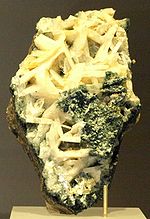Whitlockite
| Whitlockite | |
|---|---|

An example of the mineral Whitlockite on display at the Royal Ontario Museum.
|
|
| General | |
| Category | Phosphate minerals |
|
Formula (repeating unit) |
Ca9(Mg,Fe++)(PO4)6(PO3OH) |
| Strunz classification | 8.AC.45 |
| Crystal system | Trigonal |
| Crystal class | Ditrigonal pyramidal (3m) H-M symbol: (3m) |
| Space group | R3c |
| Unit cell | a = 10.33, c = 37.103(5) [Å]; Z = 3 |
| Identification | |
| Color | Colorless, gray-white, light pink, light yellow |
| Crystal habit | rhombohedral crystals, often tabular, massive, microcrystalline crusts and as "cave pearls" |
| Cleavage | None |
| Fracture | Brittle |
| Tenacity | Brittle |
| Mohs scale hardness | 5 |
| Luster | Vitreous to resinous |
| Streak | White |
| Diaphaneity | Transparent |
| Density | 3.13 |
| Optical properties | uniaxial (-) |
| Refractive index | nω = 1.629 nε = 1.626 |
| Birefringence | δ = 0.003 |
| Other characteristics | Piezoelectric and pyroelectric |
| References | |
Whitlockite is a mineral, an unusual form of calcium phosphate. Its formula is Ca9(MgFe)(PO4)6PO3OH. It is a relatively rare mineral but is found in granitic pegmatites, phosphate rock deposits, guano caves and in chondrite meteorites. It was first described in 1941 and named for Herbert Percy Whitlock (1868–1948), American mineralogist, Curator, American Museum of Natural History, New York City, NY, US.
With regards to periodontal dentistry, magnesium whitlockite comprises one component of many of the inorganic content of calculus. It is found primarily in subgingival calculus (as opposed to supragingival calculus). It is also found more in posterior as opposed to anterior regions of the oral cavity.
Whitlockite is a member of the phosphate group of minerals with three distinct occurrences. For many years, these occurrences were thought to be identical. However, recent studies using x-ray and electron diffraction have been able to identify compositional differences that separate one type of whitlockite from another. There are two inorganic occurrences of whitlockite that differ chiefly by the presence or absence of hydrogen. This difference was not initially observed due to technical limitations, such as small crystal size. Although the identity of the “true” whitlockite is still debated, efforts are now being made to officially distinguish terrestrial whitlockite from its phase in meteorites as two distinct minerals. Whitlockite can also be found in different types of biological deposits. Organic instances of whitlockite are virtually identical in composition, but typically contain magnesium, which further distinguishes them from inorganic instances of this mineral. Magnesium whitlockite has been implicated in different disease states and is currently being studied for use in the fabrication of human prosthetics.
...
Wikipedia
